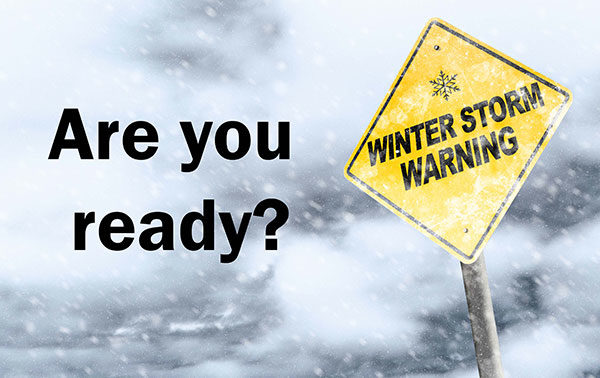What Does It Mean to “Shelter-in-Place?”

When emergencies strike, one of the directions that officials may give to the public is to “shelter-in-place.” Sheltering-in-place is an appropriate action to take when circumstances require that you seek protection—in your home, place of employment, or other location—because of dangerous conditions. Being ready to shelter-in-place, especially in your home, is something you can prepare for ahead of time.
What does it mean to “shelter-in-place?” In the Pacific Northwest, many of us do this when winter weather—in the form of ice or snow—comes to our communities. We may hit the grocery store before the storm, and stock up on milk, bread, eggs, and perhaps some comfort food. Transportation may become erratic, and sidewalks turn slippery with ice or slush, so we stay at home until conditions improve. That is an example of sheltering-in-place. Preparations ahead of time include having enough food and needed medications to see you through your stay in one place until it is safe to move about.
The same might be true of a severe windstorm, when traveling out and about—even in a car or bus—can become hazardous. Flying debris can make walking dangerous and power outages may mean traffic signals and crosswalk lights don’t work. Staying home and out of harm’s way makes sense. Again, having enough food and needed medications is one way to prepare for sheltering-in-place until the winds die down again.

Click on the sasquatch above to watch “Be Prepared for Disasters,” a video from the Seattle Office of Emergency Management.
Especially with windstorms, you should also be prepared in case you lose power. Keep fresh batteries in flashlights and have some battery-operated lights available if possible. Although candles have traditionally been a way to provide light when power is lost, they are also a fire hazard. Candles should not be your first choice for light. And remember—do not use your gas oven as a heat source or your outdoor grill for cooking indoors. Either action can cause deadly carbon monoxide poisoning.
It is useful to think ahead of time about how to shelter-in-place without power. For example, do you have a hand-operated can opener? Do you have a battery-operated radio (and batteries) to receive important emergency information? Have you kept your cell phone charged so you can communicate with family and friends or call your doctor or 911 if necessary? These are all steps you can take to be ready to shelter-in-place for more than a few hours.
Another time when sheltering-in-place may be needed is under conditions of poor or unhealthy air quality. In recent years, our area has experienced periods of excessive wildfire smoke. The Puget Sound Clean Air Agency monitors air quality and issues alerts when appropriate. (You can check current air quality conditions here.)
When conditions reach a “yellow flag” stage, people with respiratory conditions—including asthma, COPD, and even heart disease—are advised to check with their health care provider about protective actions to take. For many, that may be to shelter-in-place and avoid going outdoors or breathing outdoor air.
If smoky conditions are particularly bad, you can use towels to cover the crack under doors, and make sure windows and vents to the outside are tightly closed. Do not use fans that draw air from the outside. That can prove difficult in our many buildings without air conditioning.
In Seattle and King County, if wildfire smoke conditions combine with excessive daytime heat, cooling centers may be identified for the public. Those are places that you can go to shelter during the day to remain cool and out of smoky conditions.
In the event of a major emergency, the public may be advised to shelter-in-place until conditions stabilize. For example, in the case of a hazardous materials spill, a specific geographic area around the spill may be issued a shelter-in-place notice. This is done to avoid exposing the public to the hazardous conditions until the hazard can be contained and the area made safe again. Public officials will announce when that has occurred, so it is always a good idea to remain tuned to official sources for up-to-date information. Officials will also tell the public if any additional protective actions are necessary for those sheltering-in-place.
In the Pacific Northwest, we must always be prepared for an earthquake to occur. Although we have no way of predicting when, we do know that one day our region will experience a significant earthquake. The shelter-in-place actions listed above will also help prepare you for something more serious, like an earthquake. When the shaking starts, drop, cover, and hold on! When the shaking stops, sheltering-in-place—if your building has limited or no damage—is the best option for you and your family.
Being ready to shelter-in-place is really about being prepared for emergencies in general. For preparedness information from the City of Seattle, click here. For preparedness information from King County, click here.
Have on hand food, water, needed medications, and batteries for flashlights and radios. Keep your cell phone charged and have a communications plan so that your family and friends know where and how you are. Check on your neighbors if you can and share resources and information when possible. Know how to stay safe and how to receive official news and information. Listen to authorities and make good decisions to stay safe, wherever you may need to shelter-in-place.
Contributor Deborah Witmer is the planning coordinator for vulnerable populations on the Seattle Human Services Department Emergency Management Team.
![AgeWise King County [logo]](https://www.agewisekingcounty.org/wp-content/themes/agewisekingcounty/images/logo.png)